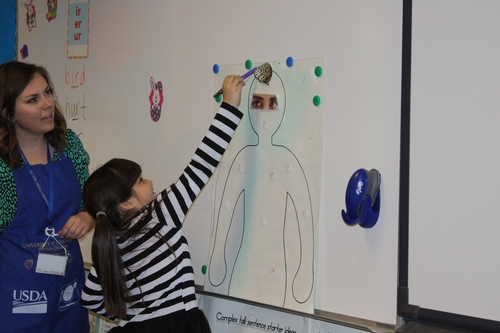UC CalFresh Nutrition Educator, Emily Harris, reflects on the experience of teaching three classes of 2nd graders during a nutrition education series. Three weeks in to the series, we get a glimpse of the successes and student feedback.
What happens when 2nd graders learn about the importance of nutrition every week? Let's find out!
Week One
The first lesson students participated in was on the difference between "anytime" snacks: foods low in sugar, salt and fat and high in nutrients and "sometimes" snacks: foods high in sugar, salt and fat. The kids learned the difference between anytime snacks like low-fat string cheese and pretzels, and sometimes snacks, like cupcakes and soda.
When I asked the kids why sugary snacks aren't good for our bodies, they had a lot of ideas! Many said that sugar makes you tired and makes your stomach hurt. One student said that sugar makes you feel like you're on a roller coast and he was definitely right! Sugar gives you a burst of energy followed by a crash that can make you tired.

In order to improve the students' snack choices I asked them what they normally would eat as a snack, then asked them what they could add or subtract to make it better for them. Many students expressed a love for cheesy crackers that contain a lot of fat. They said they would eat a piece of fruit or some veggies to make it a healthier choice, or choose pretzels instead. I left them with a challenge for eating in moderation: stick with five days of anytime snacks and two days of sometimes snacks during the upcoming week.
Week Two
I asked the students about their snack choices when I came back for week two, and a quick review helped the students remember their goal of eating anytime snacks most days of the week.
The main event was now breakfast! The students learned that three of the five food groups need to be present at breakfast time in order to stay full and satisfied until lunch. We sang the “Breakfast Shaky” (which is a breakfast version of the hokey pokey) and danced the time away as some of the students realized they hadn't been eating enough for breakfast.
All of the children were shocked when they learned that breakfast doesn't have to include typical breakfast foods like eggs and cereal; breakfast can be spaghetti, quesadillas, or even homemade pizza as long as there are three food groups with "anytime" ingredients. It took awhile for the students to believe me, and even the ones that did said their parents probably wouldn't let them eat pizza for breakfast. I encouraged them to share what they learned and see if their parents may make an exception.
This weeks challenge was for the students to eat a three food group breakfast every day during spring break.
Week Three
During week three the students learned about the ways different foods keep our bodies functioning properly.

I brought along our Mr. Healthy Body poster and used visuals to help students learn the difference between vitamin A, which helps keep our eyes healthy, and potassium, which keeps our blood flowing properly. Some of the vitamins and minerals had interactive movements to keep the students engaged and enhance their ability to differentiate between each one. When learning about vitamin A, we made "goggles" with our hands. When talking about potassium and healthy blood flow, we wiggled our bodies.

The students loved Mr. Healthy Body because he is hilarious to look at, which helped them to remember what we learned. When we talked about vitamin C, I told the students that it acts like a bubble to keep germs and disease away. One student said vitamin C is a force field, which I love even more than the bubble analogy!
I can't wait to see what happens with these students during our upcoming sessions. Stay tuned for an update on the next few weeks!
~Emily
